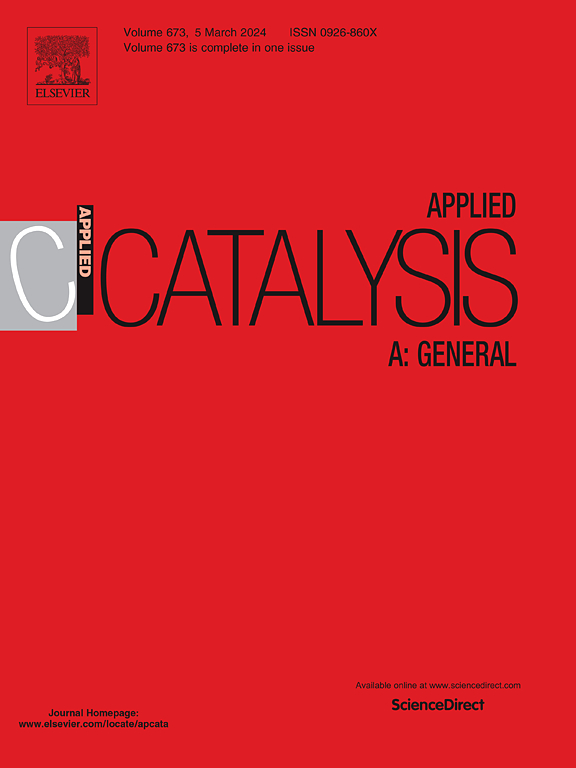探索Pd/ZrO2-TiO2在糠醛还原胺化生产仲胺中的双功能作用
IF 4.7
2区 化学
Q2 CHEMISTRY, PHYSICAL
引用次数: 0
摘要
环境问题和对可持续技术的迫切需求增加了对糠醛(FUR)胺化的兴趣,作为当前石油基胺化工艺的一种环境友好型替代品。本文以H2为还原剂,系统研究了Pd/ZrO2-TiO2在苯胺(ANI)一锅还原氨化FUR中的双功能作用。Pd/ZrO2-TiO2的结构表征为Ti原子被Zr取代,Zr位点高度分散,酸度调节。Pd/ZrO2-TiO2催化剂在连续反应图中将FUR转化为n -呋喃苯胺(FFA),包括中间亚胺(IME)的形成,并随后加氢,具有活性和稳定性。FTIR-ATR原位测量证实,在第一反应步骤中形成的水不会干扰反应性能。最后,该催化剂的有效性是由于酸位的存在增强了CO和N = H的活化,随后Pd0位点促进了加氢。本文章由计算机程序翻译,如有差异,请以英文原文为准。
Exploring the bifunctional role of Pd/ZrO2-TiO2 in the production of secondary amines via reductive amination of furfural
Environmental concerns and the pressing need for sustainable technologies have increased the interest in furfural (FUR) amination as an environmentally friendly alternative to current petroleum-based amination processes. Here we systematically investigate the bifunctional effect of Pd/ZrO2-TiO2 for the one-pot reductive amination of FUR with aniline (ANI) using H2 as the reducing agent. The structural characterization of Pd/ZrO2-TiO2 indicated Ti atom substitutions by Zr, highly dispersed Zr sites, and modulated acidity. The Pd/ZrO2-TiO2 catalyst was active and stable for converting FUR into N-furfurylaniline (FFA) following a sequential reaction map, involving the formation of an intermediate imine (IME), with subsequent hydrogenation. The water formed in the first reaction step does not interfere in the reaction performance as confirmed by FTIR-ATR in situ measurements. Finally, the effectiveness of the catalyst was explained by the presence of acid sites which enhance C![]() O and N = H activation, with subsequent hydrogenation promoted by Pd0 sites.
O and N = H activation, with subsequent hydrogenation promoted by Pd0 sites.
求助全文
通过发布文献求助,成功后即可免费获取论文全文。
去求助
来源期刊

Applied Catalysis A: General
化学-环境科学
CiteScore
9.00
自引率
5.50%
发文量
415
审稿时长
24 days
期刊介绍:
Applied Catalysis A: General publishes original papers on all aspects of catalysis of basic and practical interest to chemical scientists in both industrial and academic fields, with an emphasis onnew understanding of catalysts and catalytic reactions, new catalytic materials, new techniques, and new processes, especially those that have potential practical implications.
Papers that report results of a thorough study or optimization of systems or processes that are well understood, widely studied, or minor variations of known ones are discouraged. Authors should include statements in a separate section "Justification for Publication" of how the manuscript fits the scope of the journal in the cover letter to the editors. Submissions without such justification will be rejected without review.
 求助内容:
求助内容: 应助结果提醒方式:
应助结果提醒方式:


